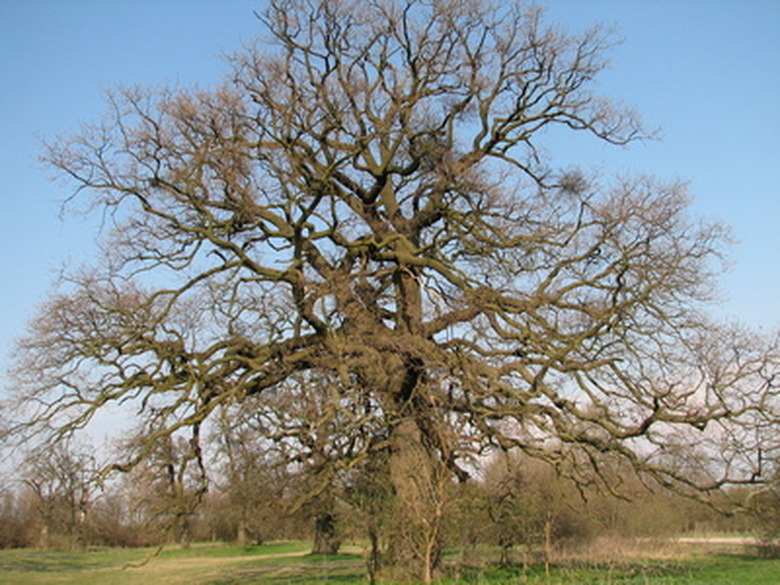Nut Bearing Trees In Pennsylvania
Pennsylvania has many varieties and species of native trees. Among these are the many types of nut-bearing trees. Many of these trees, such as the oak or hickory trees, are known to produce quality wood for furniture, boxes, oils, or instruments. Most of the nut trees are used by wildlife for food; some of these are also edible by humans as well.
Beech
The American Beech is found mainly in the north of Pennsylvania and is a main food supply for bears, squirrels, turkey and grouse. It has light green or yellowish-green glossy leaves and bears shiny nuts which are pale brown and triangular in shape.
Oak
The Black Oak tree is a common oak found in dry upland areas. The nuts, known as acorns, are round and light brown with a bowl-shaped cup covering half of the nut. The acorn is used as food for wildlife. The Northern Red Oak is a dominant tree found in forests that reaches 90 feet tall. Look for reddish-brown acorns ¾ inch to 1 ¼ inch long with a saucer-shaped cover over one-quarter of the nut. The Pin Oak is common in wet sites and is found in city landscaping. The acorns, valued by wildlife as food supply, are a round, light brown nut with striped dark lines; the saucer-shaped cup has tight scales with a dark margin and covers one-third of the nut.
- Pennsylvania has many varieties and species of native trees.
- The acorns, valued by wildlife as food supply, are a round, light brown nut with striped dark lines; the saucer-shaped cup has tight scales with a dark margin and covers one-third of the nut.
The Scarlet Oak is found in dry upland areas and is used as landscaping for parks and streets. The light brown nuts are 1 inch long with a ½-inch bowl cap. The Chestnut Oak, also called Rock or Basket Oak, grows on dry slopes and ridges. The dark brown shiny nut grows to a thin 1 ½ inches long with a knobby scaled cup covering up to half of the nut. The White Oak grows in dry or moist forest floors throughout Pennsylvania. Native Americans made flour from the acorn. Look for a long, light brown nut with a bowl-shaped cup covering ¼ of the nut.
- The Scarlet Oak is found in dry upland areas and is used as landscaping for parks and streets.
- The Chestnut Oak, also called Rock or Basket Oak, grows on dry slopes and ridges.
Hickory
Look for the Bitternut Hickory in fertile bottomland but also in well-drained upland. The round nut has a thin, yellowish dotted husk with a reddish-brown nut inside. The Mockernut Hickory has egg-shaped reddish-brown ridged nuts growing up to 2 inches long. Look in open woods and slopes for this tree.
Look for brownish-white nuts encased in 2-inch long pear-shaped thin husks in the Pignut Hickory. This tree appears on high ridgetops or slopes in southern Pennsylvania. The Shagbark Hickory is found around both slopes and valleys throughout the Commonwealth. The fruit is a 1-inch to 2 ½-inch diameter round white nut that is pointed at one end. The Native Americans used the kernel for cooking and flour for bread. Shellbark Hickory has the largest nut of the native hickories in Pennsylvania. The nut is 1 ¾ to 2 ½ inches long and is a ridged, pointed fruit that is yellowish-white to reddish brown in color. Look for the tree in wet bottomlands across the south of the state.
- Look for the Bitternut Hickory in fertile bottomland but also in well-drained upland.
- Shellbark Hickory has the largest nut of the native hickories in Pennsylvania.
Chestnut
The American Chestnut was the most common tree in Pennsylvania until chestnut blight nearly eliminated the species. Look for stump sprouts or small trees with nuts that are flat on one side. The nuts are shiny brown, reaching up to 3 inches across and clustered in groups of two or three nuts.
Butternut
Look for the Butternut, or White walnut, tree in rich bottomlands and hillsides around the northern tier. Look for an oblong 1 ½- to 2 ½-inch hairy pointed nut.
Walnut
Black walnut trees appear mainly in the southern portion of Pennsylvania. Look for round nuts with a rough shell up to 2 inches in diameter.
- The American Chestnut was the most common tree in Pennsylvania until chestnut blight nearly eliminated the species.
- Look for round nuts with a rough shell up to 2 inches in diameter.
Birch
The Sweet Birch, also known as Black Birch or Cherry Birch, is found in fertile lowlands or rocky ridge areas. Look for nuts with small scales gathered in a cone structure. The Yellow Birch is found on north-facing slopes and swamps. Look for winged nuts grouped in erect short-stalked cones.
